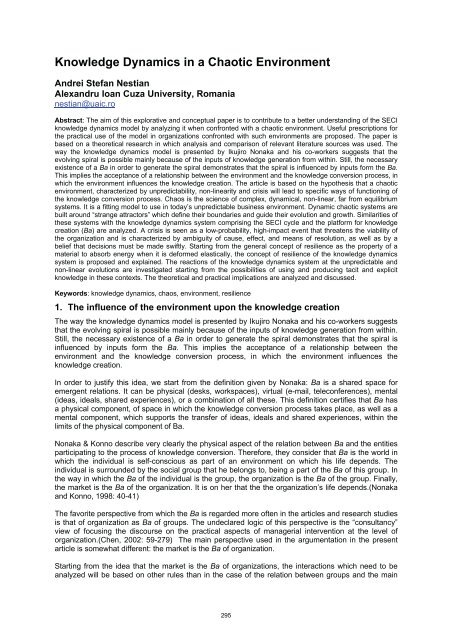Proceedings of the 3rd European Conference on Intellectual Capital
Proceedings of the 3rd European Conference on Intellectual Capital
Proceedings of the 3rd European Conference on Intellectual Capital
You also want an ePaper? Increase the reach of your titles
YUMPU automatically turns print PDFs into web optimized ePapers that Google loves.
Knowledge Dynamics in a Chaotic Envir<strong>on</strong>ment<br />
Andrei Stefan Nestian<br />
Alexandru Ioan Cuza University, Romania<br />
nestian@uaic.ro<br />
Abstract: The aim <str<strong>on</strong>g>of</str<strong>on</strong>g> this explorative and c<strong>on</strong>ceptual paper is to c<strong>on</strong>tribute to a better understanding <str<strong>on</strong>g>of</str<strong>on</strong>g> <str<strong>on</strong>g>the</str<strong>on</strong>g> SECI<br />
knowledge dynamics model by analyzing it when c<strong>on</strong>fr<strong>on</strong>ted with a chaotic envir<strong>on</strong>ment. Useful prescripti<strong>on</strong>s for<br />
<str<strong>on</strong>g>the</str<strong>on</strong>g> practical use <str<strong>on</strong>g>of</str<strong>on</strong>g> <str<strong>on</strong>g>the</str<strong>on</strong>g> model in organizati<strong>on</strong>s c<strong>on</strong>fr<strong>on</strong>ted with such envir<strong>on</strong>ments are proposed. The paper is<br />
based <strong>on</strong> a <str<strong>on</strong>g>the</str<strong>on</strong>g>oretical research in which analysis and comparis<strong>on</strong> <str<strong>on</strong>g>of</str<strong>on</strong>g> relevant literature sources was used. The<br />
way <str<strong>on</strong>g>the</str<strong>on</strong>g> knowledge dynamics model is presented by Ikujiro N<strong>on</strong>aka and his co-workers suggests that <str<strong>on</strong>g>the</str<strong>on</strong>g><br />
evolving spiral is possible mainly because <str<strong>on</strong>g>of</str<strong>on</strong>g> <str<strong>on</strong>g>the</str<strong>on</strong>g> inputs <str<strong>on</strong>g>of</str<strong>on</strong>g> knowledge generati<strong>on</strong> from within. Still, <str<strong>on</strong>g>the</str<strong>on</strong>g> necessary<br />
existence <str<strong>on</strong>g>of</str<strong>on</strong>g> a Ba in order to generate <str<strong>on</strong>g>the</str<strong>on</strong>g> spiral dem<strong>on</strong>strates that <str<strong>on</strong>g>the</str<strong>on</strong>g> spiral is influenced by inputs form <str<strong>on</strong>g>the</str<strong>on</strong>g> Ba.<br />
This implies <str<strong>on</strong>g>the</str<strong>on</strong>g> acceptance <str<strong>on</strong>g>of</str<strong>on</strong>g> a relati<strong>on</strong>ship between <str<strong>on</strong>g>the</str<strong>on</strong>g> envir<strong>on</strong>ment and <str<strong>on</strong>g>the</str<strong>on</strong>g> knowledge c<strong>on</strong>versi<strong>on</strong> process, in<br />
which <str<strong>on</strong>g>the</str<strong>on</strong>g> envir<strong>on</strong>ment influences <str<strong>on</strong>g>the</str<strong>on</strong>g> knowledge creati<strong>on</strong>. The article is based <strong>on</strong> <str<strong>on</strong>g>the</str<strong>on</strong>g> hypo<str<strong>on</strong>g>the</str<strong>on</strong>g>sis that a chaotic<br />
envir<strong>on</strong>ment, characterized by unpredictability, n<strong>on</strong>-linearity and crisis will lead to specific ways <str<strong>on</strong>g>of</str<strong>on</strong>g> functi<strong>on</strong>ing <str<strong>on</strong>g>of</str<strong>on</strong>g><br />
<str<strong>on</strong>g>the</str<strong>on</strong>g> knowledge c<strong>on</strong>versi<strong>on</strong> process. Chaos is <str<strong>on</strong>g>the</str<strong>on</strong>g> science <str<strong>on</strong>g>of</str<strong>on</strong>g> complex, dynamical, n<strong>on</strong>-linear, far from equilibrium<br />
systems. It is a fitting model to use in today’s unpredictable business envir<strong>on</strong>ment. Dynamic chaotic systems are<br />
built around “strange attractors” which define <str<strong>on</strong>g>the</str<strong>on</strong>g>ir boundaries and guide <str<strong>on</strong>g>the</str<strong>on</strong>g>ir evoluti<strong>on</strong> and growth. Similarities <str<strong>on</strong>g>of</str<strong>on</strong>g><br />
<str<strong>on</strong>g>the</str<strong>on</strong>g>se systems with <str<strong>on</strong>g>the</str<strong>on</strong>g> knowledge dynamics system comprising <str<strong>on</strong>g>the</str<strong>on</strong>g> SECI cycle and <str<strong>on</strong>g>the</str<strong>on</strong>g> platform for knowledge<br />
creati<strong>on</strong> (Ba) are analyzed. A crisis is seen as a low-probability, high-impact event that threatens <str<strong>on</strong>g>the</str<strong>on</strong>g> viability <str<strong>on</strong>g>of</str<strong>on</strong>g><br />
<str<strong>on</strong>g>the</str<strong>on</strong>g> organizati<strong>on</strong> and is characterized by ambiguity <str<strong>on</strong>g>of</str<strong>on</strong>g> cause, effect, and means <str<strong>on</strong>g>of</str<strong>on</strong>g> resoluti<strong>on</strong>, as well as by a<br />
belief that decisi<strong>on</strong>s must be made swiftly. Starting from <str<strong>on</strong>g>the</str<strong>on</strong>g> general c<strong>on</strong>cept <str<strong>on</strong>g>of</str<strong>on</strong>g> resilience as <str<strong>on</strong>g>the</str<strong>on</strong>g> property <str<strong>on</strong>g>of</str<strong>on</strong>g> a<br />
material to absorb energy when it is deformed elastically, <str<strong>on</strong>g>the</str<strong>on</strong>g> c<strong>on</strong>cept <str<strong>on</strong>g>of</str<strong>on</strong>g> resilience <str<strong>on</strong>g>of</str<strong>on</strong>g> <str<strong>on</strong>g>the</str<strong>on</strong>g> knowledge dynamics<br />
system is proposed and explained. The reacti<strong>on</strong>s <str<strong>on</strong>g>of</str<strong>on</strong>g> <str<strong>on</strong>g>the</str<strong>on</strong>g> knowledge dynamics system at <str<strong>on</strong>g>the</str<strong>on</strong>g> unpredictable and<br />
n<strong>on</strong>-linear evoluti<strong>on</strong>s are investigated starting from <str<strong>on</strong>g>the</str<strong>on</strong>g> possibilities <str<strong>on</strong>g>of</str<strong>on</strong>g> using and producing tacit and explicit<br />
knowledge in <str<strong>on</strong>g>the</str<strong>on</strong>g>se c<strong>on</strong>texts. The <str<strong>on</strong>g>the</str<strong>on</strong>g>oretical and practical implicati<strong>on</strong>s are analyzed and discussed.<br />
Keywords: knowledge dynamics, chaos, envir<strong>on</strong>ment, resilience<br />
1. The influence <str<strong>on</strong>g>of</str<strong>on</strong>g> <str<strong>on</strong>g>the</str<strong>on</strong>g> envir<strong>on</strong>ment up<strong>on</strong> <str<strong>on</strong>g>the</str<strong>on</strong>g> knowledge creati<strong>on</strong><br />
The way <str<strong>on</strong>g>the</str<strong>on</strong>g> knowledge dynamics model is presented by Ikujiro N<strong>on</strong>aka and his co-workers suggests<br />
that <str<strong>on</strong>g>the</str<strong>on</strong>g> evolving spiral is possible mainly because <str<strong>on</strong>g>of</str<strong>on</strong>g> <str<strong>on</strong>g>the</str<strong>on</strong>g> inputs <str<strong>on</strong>g>of</str<strong>on</strong>g> knowledge generati<strong>on</strong> from within.<br />
Still, <str<strong>on</strong>g>the</str<strong>on</strong>g> necessary existence <str<strong>on</strong>g>of</str<strong>on</strong>g> a Ba in order to generate <str<strong>on</strong>g>the</str<strong>on</strong>g> spiral dem<strong>on</strong>strates that <str<strong>on</strong>g>the</str<strong>on</strong>g> spiral is<br />
influenced by inputs form <str<strong>on</strong>g>the</str<strong>on</strong>g> Ba. This implies <str<strong>on</strong>g>the</str<strong>on</strong>g> acceptance <str<strong>on</strong>g>of</str<strong>on</strong>g> a relati<strong>on</strong>ship between <str<strong>on</strong>g>the</str<strong>on</strong>g><br />
envir<strong>on</strong>ment and <str<strong>on</strong>g>the</str<strong>on</strong>g> knowledge c<strong>on</strong>versi<strong>on</strong> process, in which <str<strong>on</strong>g>the</str<strong>on</strong>g> envir<strong>on</strong>ment influences <str<strong>on</strong>g>the</str<strong>on</strong>g><br />
knowledge creati<strong>on</strong>.<br />
In order to justify this idea, we start from <str<strong>on</strong>g>the</str<strong>on</strong>g> definiti<strong>on</strong> given by N<strong>on</strong>aka: Ba is a shared space for<br />
emergent relati<strong>on</strong>s. It can be physical (desks, workspaces), virtual (e-mail, telec<strong>on</strong>ferences), mental<br />
(ideas, ideals, shared experiences), or a combinati<strong>on</strong> <str<strong>on</strong>g>of</str<strong>on</strong>g> all <str<strong>on</strong>g>the</str<strong>on</strong>g>se. This definiti<strong>on</strong> certifies that Ba has<br />
a physical comp<strong>on</strong>ent, <str<strong>on</strong>g>of</str<strong>on</strong>g> space in which <str<strong>on</strong>g>the</str<strong>on</strong>g> knowledge c<strong>on</strong>versi<strong>on</strong> process takes place, as well as a<br />
mental comp<strong>on</strong>ent, which supports <str<strong>on</strong>g>the</str<strong>on</strong>g> transfer <str<strong>on</strong>g>of</str<strong>on</strong>g> ideas, ideals and shared experiences, within <str<strong>on</strong>g>the</str<strong>on</strong>g><br />
limits <str<strong>on</strong>g>of</str<strong>on</strong>g> <str<strong>on</strong>g>the</str<strong>on</strong>g> physical comp<strong>on</strong>ent <str<strong>on</strong>g>of</str<strong>on</strong>g> Ba.<br />
N<strong>on</strong>aka & K<strong>on</strong>no describe very clearly <str<strong>on</strong>g>the</str<strong>on</strong>g> physical aspect <str<strong>on</strong>g>of</str<strong>on</strong>g> <str<strong>on</strong>g>the</str<strong>on</strong>g> relati<strong>on</strong> between Ba and <str<strong>on</strong>g>the</str<strong>on</strong>g> entities<br />
participating to <str<strong>on</strong>g>the</str<strong>on</strong>g> process <str<strong>on</strong>g>of</str<strong>on</strong>g> knowledge c<strong>on</strong>versi<strong>on</strong>. Therefore, <str<strong>on</strong>g>the</str<strong>on</strong>g>y c<strong>on</strong>sider that Ba is <str<strong>on</strong>g>the</str<strong>on</strong>g> world in<br />
which <str<strong>on</strong>g>the</str<strong>on</strong>g> individual is self-c<strong>on</strong>scious as part <str<strong>on</strong>g>of</str<strong>on</strong>g> an envir<strong>on</strong>ment <strong>on</strong> which his life depends. The<br />
individual is surrounded by <str<strong>on</strong>g>the</str<strong>on</strong>g> social group that he bel<strong>on</strong>gs to, being a part <str<strong>on</strong>g>of</str<strong>on</strong>g> <str<strong>on</strong>g>the</str<strong>on</strong>g> Ba <str<strong>on</strong>g>of</str<strong>on</strong>g> this group. In<br />
<str<strong>on</strong>g>the</str<strong>on</strong>g> way in which <str<strong>on</strong>g>the</str<strong>on</strong>g> Ba <str<strong>on</strong>g>of</str<strong>on</strong>g> <str<strong>on</strong>g>the</str<strong>on</strong>g> individual is <str<strong>on</strong>g>the</str<strong>on</strong>g> group, <str<strong>on</strong>g>the</str<strong>on</strong>g> organizati<strong>on</strong> is <str<strong>on</strong>g>the</str<strong>on</strong>g> Ba <str<strong>on</strong>g>of</str<strong>on</strong>g> <str<strong>on</strong>g>the</str<strong>on</strong>g> group. Finally,<br />
<str<strong>on</strong>g>the</str<strong>on</strong>g> market is <str<strong>on</strong>g>the</str<strong>on</strong>g> Ba <str<strong>on</strong>g>of</str<strong>on</strong>g> <str<strong>on</strong>g>the</str<strong>on</strong>g> organizati<strong>on</strong>. It is <strong>on</strong> her that <str<strong>on</strong>g>the</str<strong>on</strong>g> <str<strong>on</strong>g>the</str<strong>on</strong>g> organizati<strong>on</strong>’s life depends.(N<strong>on</strong>aka<br />
and K<strong>on</strong>no, 1998: 40-41)<br />
The favorite perspective from which <str<strong>on</strong>g>the</str<strong>on</strong>g> Ba is regarded more <str<strong>on</strong>g>of</str<strong>on</strong>g>ten in <str<strong>on</strong>g>the</str<strong>on</strong>g> articles and research studies<br />
is that <str<strong>on</strong>g>of</str<strong>on</strong>g> organizati<strong>on</strong> as Ba <str<strong>on</strong>g>of</str<strong>on</strong>g> groups. The undeclared logic <str<strong>on</strong>g>of</str<strong>on</strong>g> this perspective is <str<strong>on</strong>g>the</str<strong>on</strong>g> “c<strong>on</strong>sultancy”<br />
view <str<strong>on</strong>g>of</str<strong>on</strong>g> focusing <str<strong>on</strong>g>the</str<strong>on</strong>g> discourse <strong>on</strong> <str<strong>on</strong>g>the</str<strong>on</strong>g> practical aspects <str<strong>on</strong>g>of</str<strong>on</strong>g> managerial interventi<strong>on</strong> at <str<strong>on</strong>g>the</str<strong>on</strong>g> level <str<strong>on</strong>g>of</str<strong>on</strong>g><br />
organizati<strong>on</strong>.(Chen, 2002: 59-279) The main perspective used in <str<strong>on</strong>g>the</str<strong>on</strong>g> argumentati<strong>on</strong> in <str<strong>on</strong>g>the</str<strong>on</strong>g> present<br />
article is somewhat different: <str<strong>on</strong>g>the</str<strong>on</strong>g> market is <str<strong>on</strong>g>the</str<strong>on</strong>g> Ba <str<strong>on</strong>g>of</str<strong>on</strong>g> organizati<strong>on</strong>.<br />
Starting from <str<strong>on</strong>g>the</str<strong>on</strong>g> idea that <str<strong>on</strong>g>the</str<strong>on</strong>g> market is <str<strong>on</strong>g>the</str<strong>on</strong>g> Ba <str<strong>on</strong>g>of</str<strong>on</strong>g> organizati<strong>on</strong>s, <str<strong>on</strong>g>the</str<strong>on</strong>g> interacti<strong>on</strong>s which need to be<br />
analyzed will be based <strong>on</strong> o<str<strong>on</strong>g>the</str<strong>on</strong>g>r rules than in <str<strong>on</strong>g>the</str<strong>on</strong>g> case <str<strong>on</strong>g>of</str<strong>on</strong>g> <str<strong>on</strong>g>the</str<strong>on</strong>g> relati<strong>on</strong> between groups and <str<strong>on</strong>g>the</str<strong>on</strong>g> main<br />
295
















